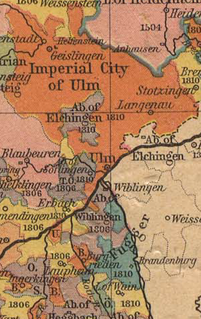
Hohenzollern-Sigmaringen was a principality in Southwestern Germany. Its rulers belonged to the senior Swabian branch of the House of Hohenzollern. The Swabian Hohenzollerns were elevated to princes in 1623. The small sovereign state with the capital city of Sigmaringen was annexed to the Kingdom of Prussia in 1850 following the abdication of its sovereign in the wake of the revolutions of 1848, then became part of the newly created Province of Hohenzollern.

Fugger is a German upper bourgeois family that was historically a prominent group of European bankers, members of the fifteenth- and sixteenth-century mercantile patriciate of Augsburg, international mercantile bankers, and venture capitalists. Alongside the Welser family, the Fugger family controlled much of the European economy in the sixteenth century and accumulated enormous wealth. The Fuggers held a near monopoly on the European copper market.

Berg was a state—originally a county, later a duchy—in the Rhineland of Germany. Its capital was Düsseldorf. It existed as a distinct political entity from the early 12th to the 19th centuries.

Gottfried Heinrich Graf zu Pappenheim was a field marshal of the Holy Roman Empire in the Thirty Years' War.
Pappenheim was a German statelet in western Bavaria, Germany, located on the Altmühl river between Treuchtlingen and Solnhofen, and south of Weißenburg. As former sovereign family, later mediatized to Bavaria in 1806 the family belongs to High nobility.

Hohenzollern-Hechingen was a small principality in southwestern Germany. Its rulers belonged to the Swabian branch of the Hohenzollern dynasty.

Prince Hans Ulrich von Eggenberg was an Austrian statesman, a son of Seyfried von Eggenberg, Lord of Erbersdorf (1526-1594), and great-grandson of Balthasar Eggenberger. He was a prominent member of the House of Eggenberg and gained the title of Duke of Krumau.

Jülich-Cleves-Berg was the name of two former territories across the modern German state of North Rhine-Westphalia and the modern Dutch province of Gelderland. From 1521 to 1666, the territory was a combination of states in personal union, all reichsfrei territories of the Holy Roman Empire. The name was resurrected after the Congress of Vienna for a short-lived province of the Kingdom of Prussia between 1815 and 1822.

Treuchtlingen is a town in the Weißenburg-Gunzenhausen district, in Bavaria, Germany. It has a population of around 12,000.

The Electorate of Saxony was a state of the Holy Roman Empire established when Emperor Charles IV raised the Ascanian duchy of Saxe-Wittenberg to the status of an Electorate by the Golden Bull of 1356. It comprised a territory of some 40,000 square kilometers. Upon the extinction of the House of Ascania, it was feoffed to the Margraves of Meissen from the Wettin dynasty in 1423, who moved the ducal residence up the river Elbe to Dresden. After the Empire's dissolution in 1806, the Wettin Electors raised Saxony to a territorially reduced kingdom.

Henry V of Brunswick-Wolfenbüttel, called the Younger,, a member of the House of Welf, was Duke of Brunswick-Lüneburg and ruling Prince of Brunswick-Wolfenbüttel from 1514 until his death. The last Catholic of the Welf princes, he was known for the large number of wars in which he was involved and for the long-standing affair with his mistress Eva von Trott.

The County of Württemberg was a historical territory with origins in the realm of the House of Württemberg, the heart of the old Duchy of Swabia. Its capital was Stuttgart. From the 12th century until 1495, it was a county within the Holy Roman Empire. It later became a duchy and, after the breakup of the Holy Roman Empire, a kingdom.

Helfenstein was a German noble family during the High and Late Middle Ages. The family was named after the family castle, Castle Helfenstein, located above Geislingen an der Steige in the Swabian Alb region of Baden-Württemberg, Germany. The family held the rank of Graf or Count and was very significant in the 13th and 14th Centuries, but fell into financial difficulties and the family died out by 1627.

Eggenberg was the name of an Austrian noble family from Styria, who achieved princely rank in the 17th century. The family's last male heir died in 1717, bringing an end to the House of Eggenberg.
Pappenheim-Alesheim was a statelet in the Holy Roman Empire that existed from 1444 until 1697.
Pappenheim-Treuchtlingen was a statelet in the Holy Roman Empire that existed from 1444 until 1647.
Pappenheim-Gräfenthal was a statelet in the Holy Roman Empire that existed from 1444 until 1599.
Pappenheim-Allgäu was a statelet in the Holy Roman Empire that existed from 1444 until it was partitioned in 1494.












